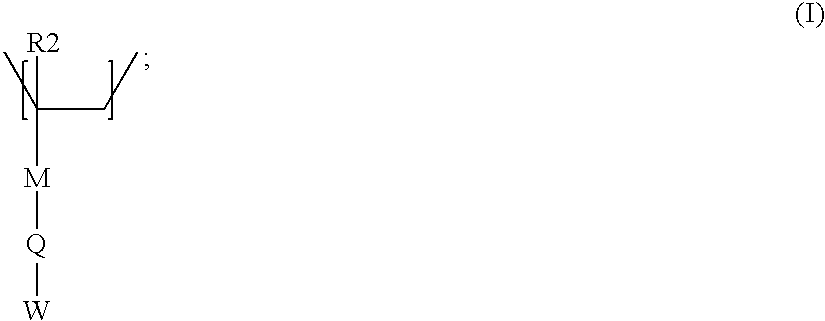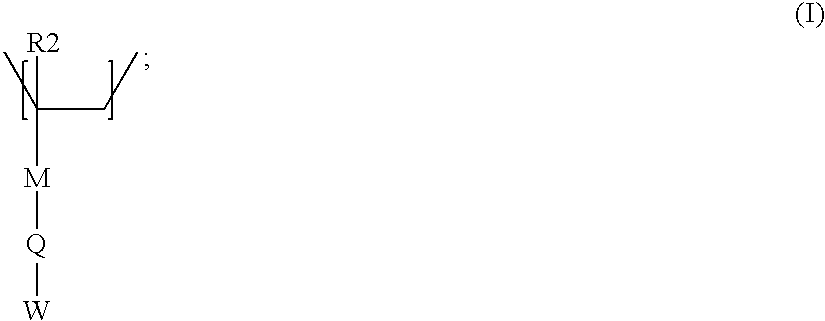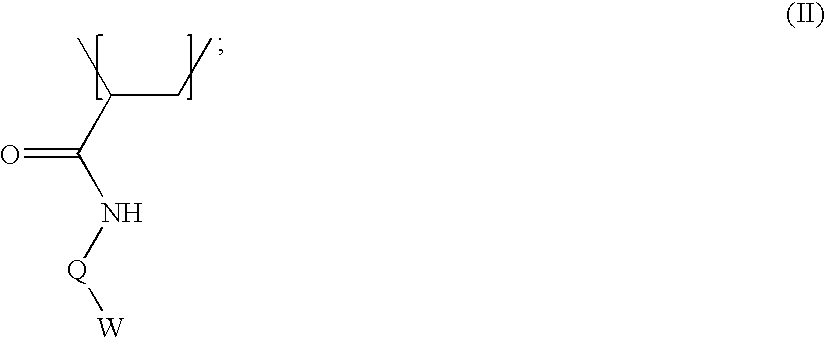Fat-binding polymers
a polymer and polymer technology, applied in the field of fat-binding polymers, can solve the problems of limited food sources which can be used in a low-fat diet, difficult acceptance of low-fat diets and the maintenance of such diets, and associated serious side effects, so as to prevent side effects, effectively bind, absorb or associate, and minimal systemic side effects
- Summary
- Abstract
- Description
- Claims
- Application Information
AI Technical Summary
Benefits of technology
Problems solved by technology
Method used
Image
Examples
example 1
Synthesis of Poly(N-Diethanolaminopropyl)Acrylamide
[0061]Step 1: Synthesis of (N-Diethanolaminopropyl)Acrylamide
[0062]A 2-liter, 3-necked, round-bottomed flask with overhead stirring was charged with 80.08 grams of N-(3-aminopropyl)diethanolamine and 200 milliliters of deionized water. To this mixture was added 3.18 grams of K2CO3 and the resulting solution was cooled to less than 5° C. with an ice bath. One hundred thirty milliliters of dichloromethane was added with vigorous stirring. This was followed by the addition of 45.0 milliliters of acryloylchloride in 50 milliliters of dichloromethane.
[0063]A 50% aqueous solution of KOH was prepared by dissolving 20.58 grams of KOH in 25 milliliters of deionized water. About half of the acryloylchloride solution was added over 30 to 45 minutes until the pH was between 7 and 8. The KOH solution and the acryloylchloride solution were then added dropwise simultaneously, keeping the pH between 8 and 9. The reaction was stirred overnight and a...
example 2
Poly(N-Diethanolaminopropylacrylamide) Reduces Free, Unabsorbed Fat in Rat Feces
[0068]The model consists of male, Sprague Dawley rats obtained from Taconic Farms, 200 g, housed individually in wire mesh cages. They were acclimated to the facility for six days, during which time they were fed a chow based diet supplemented with 15 percent lard by weight. Feed and water were provided ad libitum. The animals were then randomly assigned to groups of five and fed test diets for three days. The test diet was also a chow based feed. A lipase inhibitor (Orlistat) was added at 0.04 percent by weight and poly(N-diethanolaminopropyl)acrylamide was added at 0.10–0.50 percent by weight. Orlistat was mixed in the feed as a powder, while the polymer was first dissolved in 20 mL water and then mixed in the feed, followed by the addition of the supplemented fat in the form of lard at 15 percent by weight. During the final 24 hours of the treatment period an 8.5″×11″ sheet of white paper was placed b...
PUM
| Property | Measurement | Unit |
|---|---|---|
| Fraction | aaaaa | aaaaa |
| Fraction | aaaaa | aaaaa |
| Fraction | aaaaa | aaaaa |
Abstract
Description
Claims
Application Information
 Login to View More
Login to View More - R&D
- Intellectual Property
- Life Sciences
- Materials
- Tech Scout
- Unparalleled Data Quality
- Higher Quality Content
- 60% Fewer Hallucinations
Browse by: Latest US Patents, China's latest patents, Technical Efficacy Thesaurus, Application Domain, Technology Topic, Popular Technical Reports.
© 2025 PatSnap. All rights reserved.Legal|Privacy policy|Modern Slavery Act Transparency Statement|Sitemap|About US| Contact US: help@patsnap.com



